Tourism Planning Environment: Critique and Comparison of Papers
VerifiedAdded on 2023/06/09
|11
|2411
|467
Report
AI Summary
This report critically analyzes two tourism discussion papers, focusing on their effectiveness in addressing sustainable tourism and the policy planning cycle. The author, assuming the role of an independent tourism planning expert, evaluates the structure, content, and stakeholder perspectives presented in each paper. The report compares the papers' strengths and weaknesses, assessing their ability to identify issues, analyze the environment, and propose solutions. The analysis considers the utility of the content from a stakeholder's perspective, evaluating whether the papers provide sufficient information for understanding the current scenario. The author also includes a self-reflection based on their learning from the papers, highlighting the importance of effective planning and the policy planning cycle in tourism development. The conclusion summarizes the findings, emphasizing the significance of a well-organized and informative approach in tourism discussion papers.
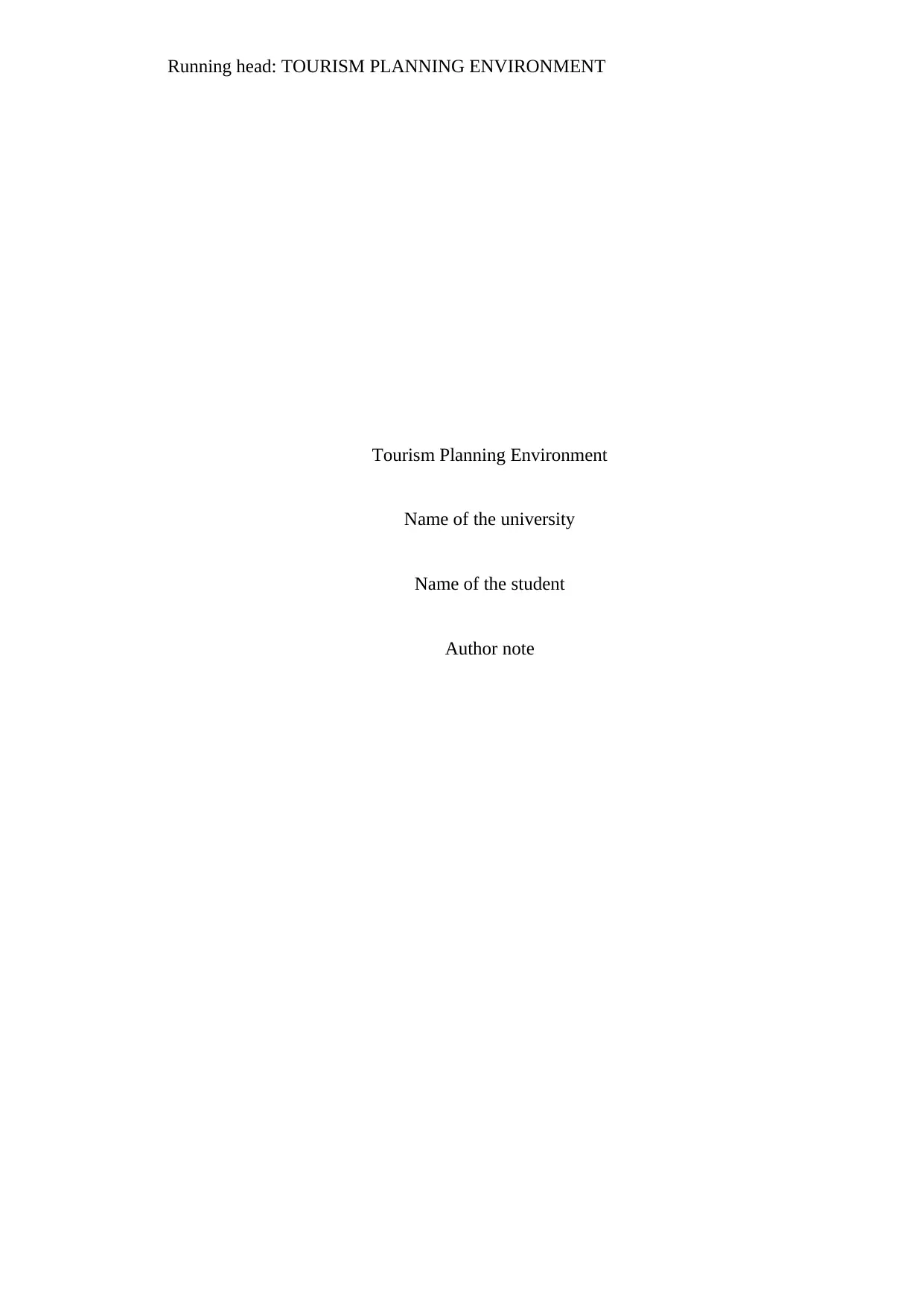
Running head: TOURISM PLANNING ENVIRONMENT
Tourism Planning Environment
Name of the university
Name of the student
Author note
Tourism Planning Environment
Name of the university
Name of the student
Author note
Paraphrase This Document
Need a fresh take? Get an instant paraphrase of this document with our AI Paraphraser
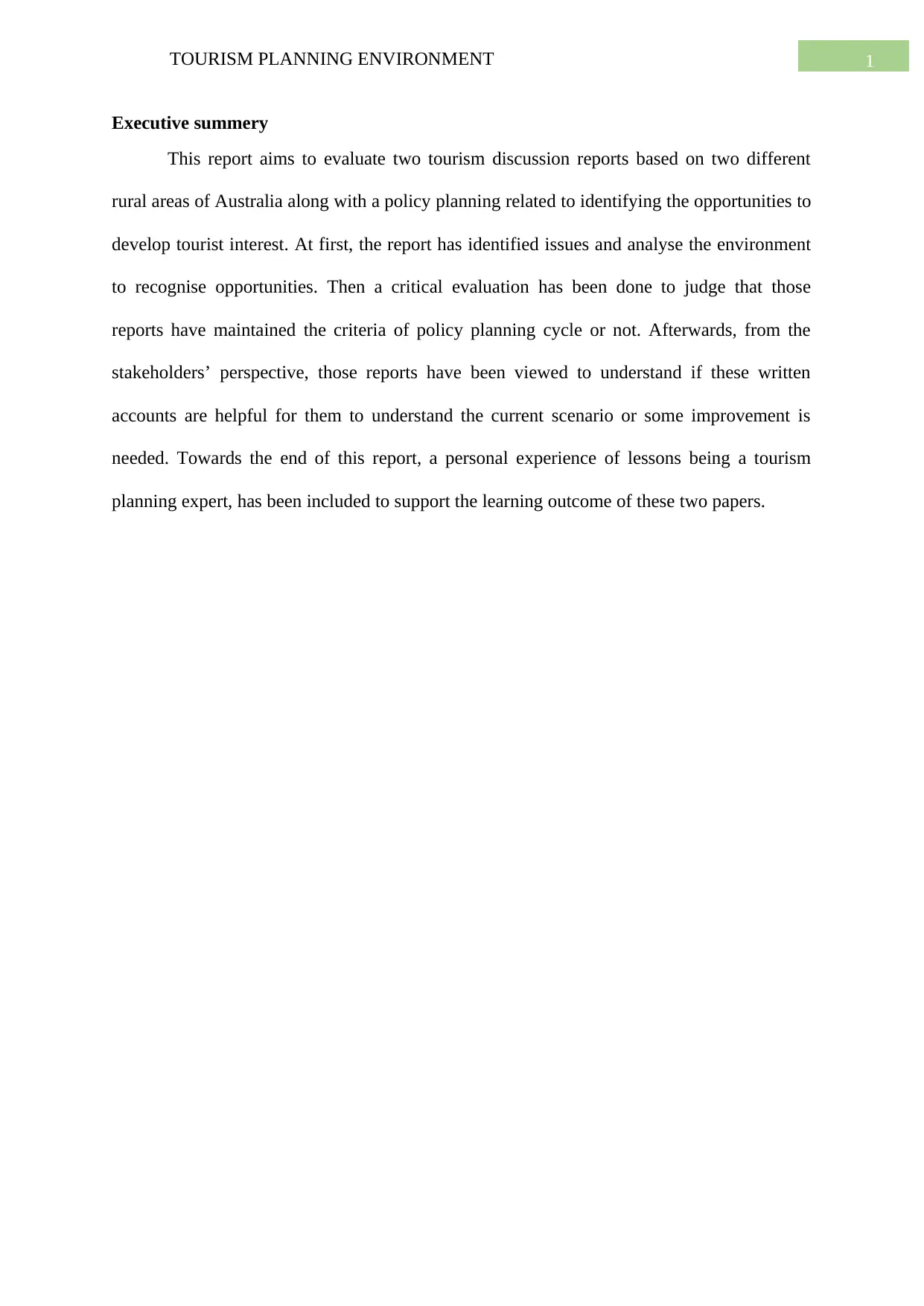
1TOURISM PLANNING ENVIRONMENT
Executive summery
This report aims to evaluate two tourism discussion reports based on two different
rural areas of Australia along with a policy planning related to identifying the opportunities to
develop tourist interest. At first, the report has identified issues and analyse the environment
to recognise opportunities. Then a critical evaluation has been done to judge that those
reports have maintained the criteria of policy planning cycle or not. Afterwards, from the
stakeholders’ perspective, those reports have been viewed to understand if these written
accounts are helpful for them to understand the current scenario or some improvement is
needed. Towards the end of this report, a personal experience of lessons being a tourism
planning expert, has been included to support the learning outcome of these two papers.
Executive summery
This report aims to evaluate two tourism discussion reports based on two different
rural areas of Australia along with a policy planning related to identifying the opportunities to
develop tourist interest. At first, the report has identified issues and analyse the environment
to recognise opportunities. Then a critical evaluation has been done to judge that those
reports have maintained the criteria of policy planning cycle or not. Afterwards, from the
stakeholders’ perspective, those reports have been viewed to understand if these written
accounts are helpful for them to understand the current scenario or some improvement is
needed. Towards the end of this report, a personal experience of lessons being a tourism
planning expert, has been included to support the learning outcome of these two papers.
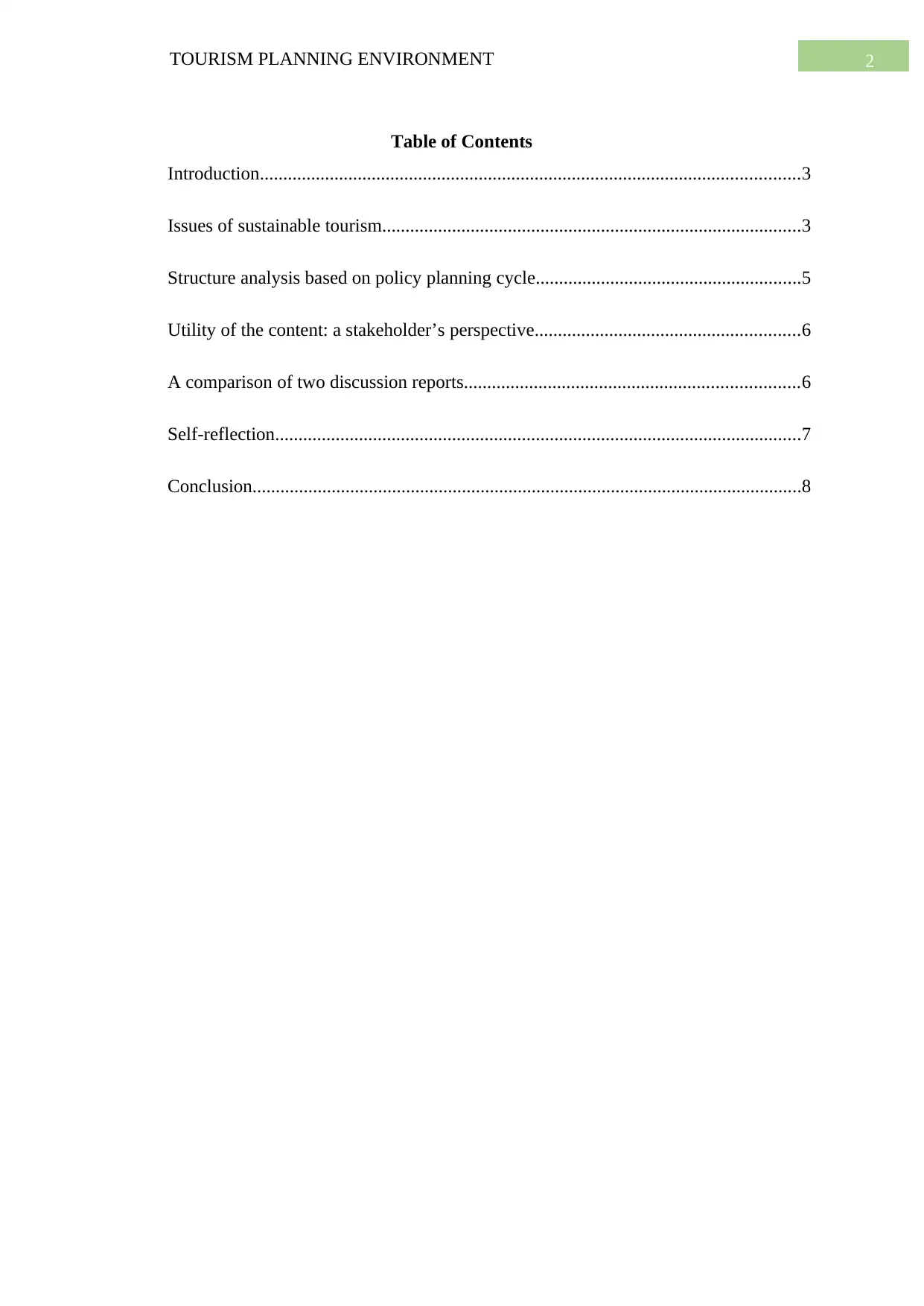
2TOURISM PLANNING ENVIRONMENT
Table of Contents
Introduction....................................................................................................................3
Issues of sustainable tourism..........................................................................................3
Structure analysis based on policy planning cycle.........................................................5
Utility of the content: a stakeholder’s perspective.........................................................6
A comparison of two discussion reports........................................................................6
Self-reflection.................................................................................................................7
Conclusion......................................................................................................................8
Table of Contents
Introduction....................................................................................................................3
Issues of sustainable tourism..........................................................................................3
Structure analysis based on policy planning cycle.........................................................5
Utility of the content: a stakeholder’s perspective.........................................................6
A comparison of two discussion reports........................................................................6
Self-reflection.................................................................................................................7
Conclusion......................................................................................................................8
⊘ This is a preview!⊘
Do you want full access?
Subscribe today to unlock all pages.

Trusted by 1+ million students worldwide
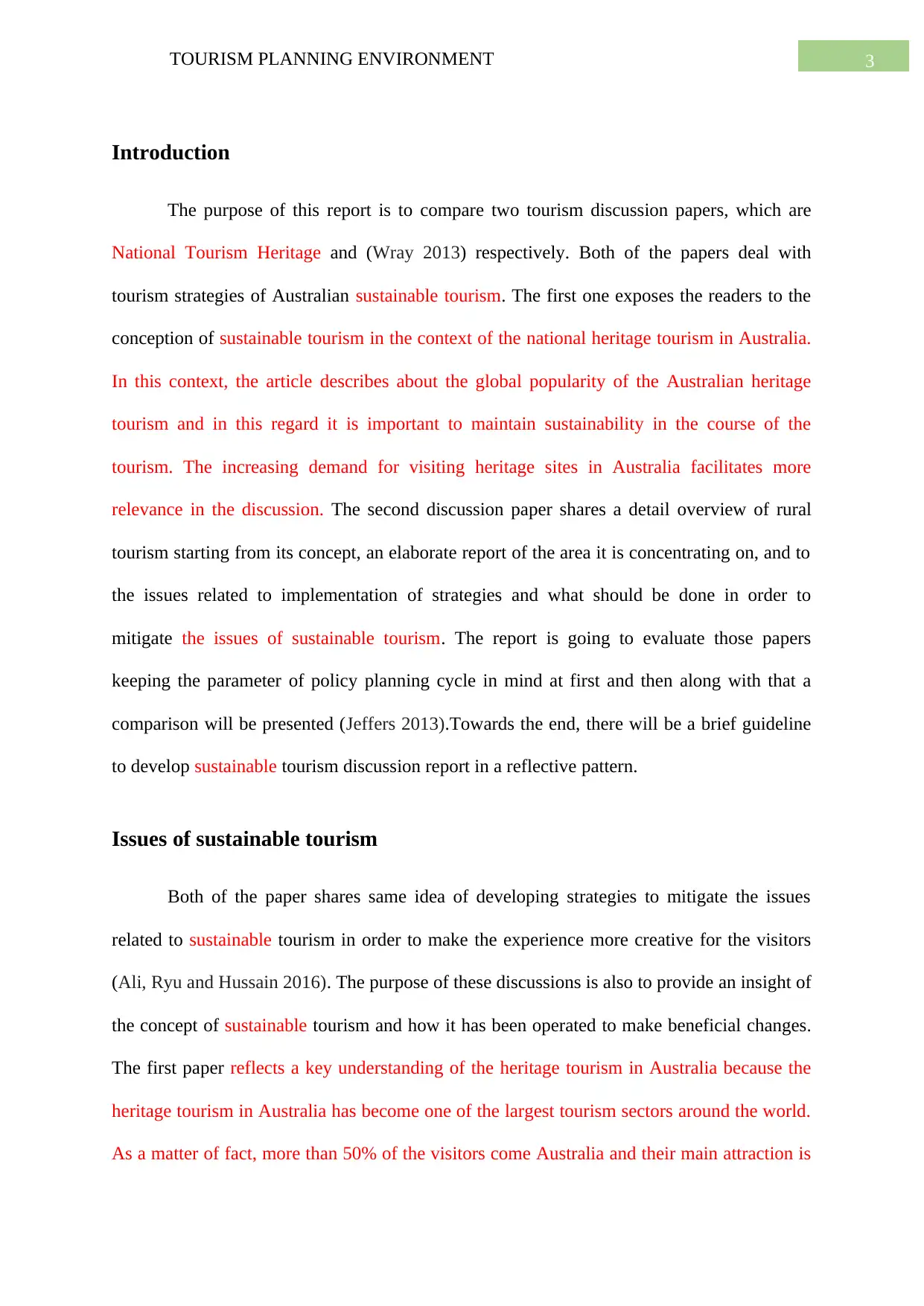
3TOURISM PLANNING ENVIRONMENT
Introduction
The purpose of this report is to compare two tourism discussion papers, which are
National Tourism Heritage and (Wray 2013) respectively. Both of the papers deal with
tourism strategies of Australian sustainable tourism. The first one exposes the readers to the
conception of sustainable tourism in the context of the national heritage tourism in Australia.
In this context, the article describes about the global popularity of the Australian heritage
tourism and in this regard it is important to maintain sustainability in the course of the
tourism. The increasing demand for visiting heritage sites in Australia facilitates more
relevance in the discussion. The second discussion paper shares a detail overview of rural
tourism starting from its concept, an elaborate report of the area it is concentrating on, and to
the issues related to implementation of strategies and what should be done in order to
mitigate the issues of sustainable tourism. The report is going to evaluate those papers
keeping the parameter of policy planning cycle in mind at first and then along with that a
comparison will be presented (Jeffers 2013).Towards the end, there will be a brief guideline
to develop sustainable tourism discussion report in a reflective pattern.
Issues of sustainable tourism
Both of the paper shares same idea of developing strategies to mitigate the issues
related to sustainable tourism in order to make the experience more creative for the visitors
(Ali, Ryu and Hussain 2016). The purpose of these discussions is also to provide an insight of
the concept of sustainable tourism and how it has been operated to make beneficial changes.
The first paper reflects a key understanding of the heritage tourism in Australia because the
heritage tourism in Australia has become one of the largest tourism sectors around the world.
As a matter of fact, more than 50% of the visitors come Australia and their main attraction is
Introduction
The purpose of this report is to compare two tourism discussion papers, which are
National Tourism Heritage and (Wray 2013) respectively. Both of the papers deal with
tourism strategies of Australian sustainable tourism. The first one exposes the readers to the
conception of sustainable tourism in the context of the national heritage tourism in Australia.
In this context, the article describes about the global popularity of the Australian heritage
tourism and in this regard it is important to maintain sustainability in the course of the
tourism. The increasing demand for visiting heritage sites in Australia facilitates more
relevance in the discussion. The second discussion paper shares a detail overview of rural
tourism starting from its concept, an elaborate report of the area it is concentrating on, and to
the issues related to implementation of strategies and what should be done in order to
mitigate the issues of sustainable tourism. The report is going to evaluate those papers
keeping the parameter of policy planning cycle in mind at first and then along with that a
comparison will be presented (Jeffers 2013).Towards the end, there will be a brief guideline
to develop sustainable tourism discussion report in a reflective pattern.
Issues of sustainable tourism
Both of the paper shares same idea of developing strategies to mitigate the issues
related to sustainable tourism in order to make the experience more creative for the visitors
(Ali, Ryu and Hussain 2016). The purpose of these discussions is also to provide an insight of
the concept of sustainable tourism and how it has been operated to make beneficial changes.
The first paper reflects a key understanding of the heritage tourism in Australia because the
heritage tourism in Australia has become one of the largest tourism sectors around the world.
As a matter of fact, more than 50% of the visitors come Australia and their main attraction is
Paraphrase This Document
Need a fresh take? Get an instant paraphrase of this document with our AI Paraphraser
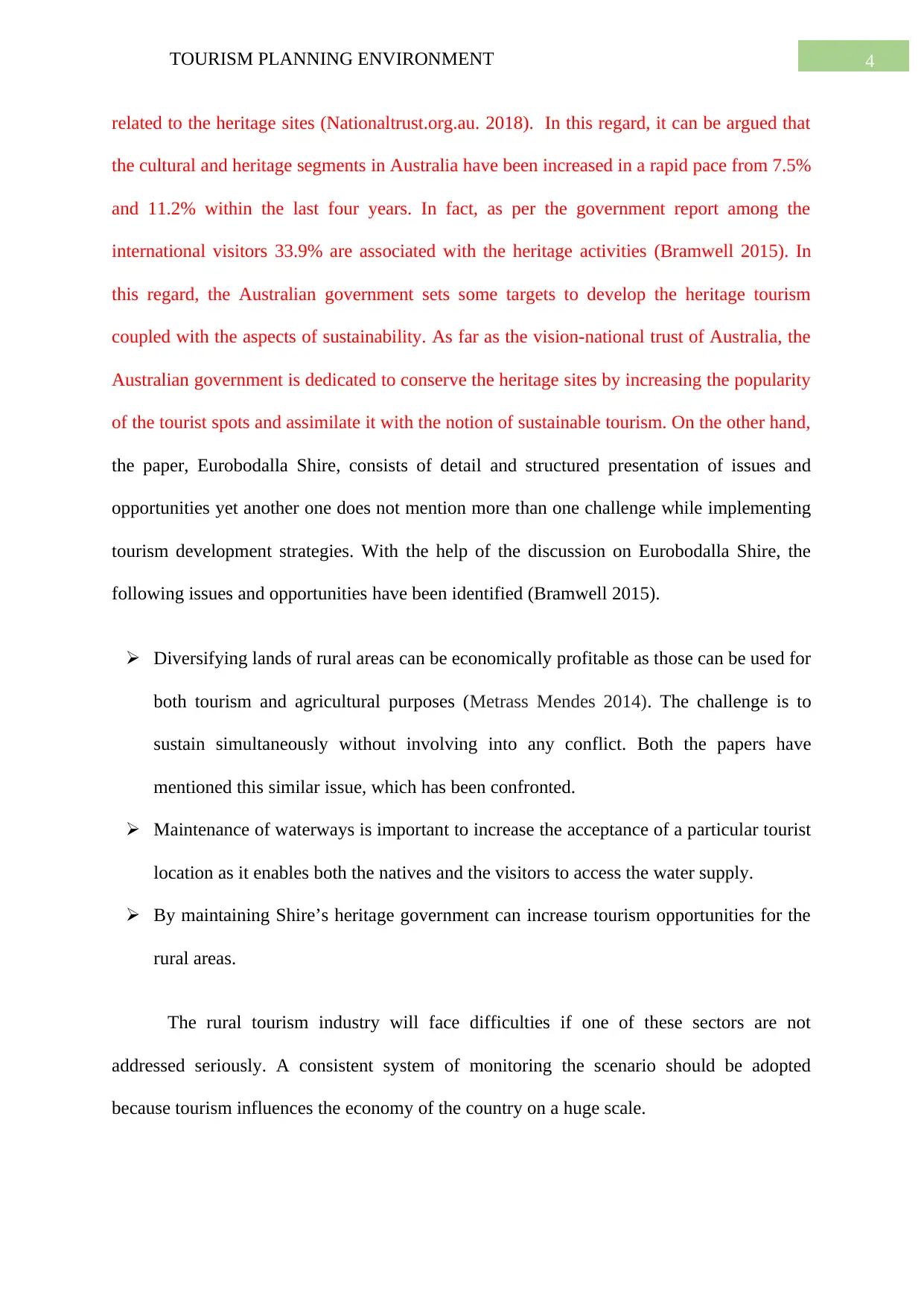
4TOURISM PLANNING ENVIRONMENT
related to the heritage sites (Nationaltrust.org.au. 2018). In this regard, it can be argued that
the cultural and heritage segments in Australia have been increased in a rapid pace from 7.5%
and 11.2% within the last four years. In fact, as per the government report among the
international visitors 33.9% are associated with the heritage activities (Bramwell 2015). In
this regard, the Australian government sets some targets to develop the heritage tourism
coupled with the aspects of sustainability. As far as the vision-national trust of Australia, the
Australian government is dedicated to conserve the heritage sites by increasing the popularity
of the tourist spots and assimilate it with the notion of sustainable tourism. On the other hand,
the paper, Eurobodalla Shire, consists of detail and structured presentation of issues and
opportunities yet another one does not mention more than one challenge while implementing
tourism development strategies. With the help of the discussion on Eurobodalla Shire, the
following issues and opportunities have been identified (Bramwell 2015).
Diversifying lands of rural areas can be economically profitable as those can be used for
both tourism and agricultural purposes (Metrass Mendes 2014). The challenge is to
sustain simultaneously without involving into any conflict. Both the papers have
mentioned this similar issue, which has been confronted.
Maintenance of waterways is important to increase the acceptance of a particular tourist
location as it enables both the natives and the visitors to access the water supply.
By maintaining Shire’s heritage government can increase tourism opportunities for the
rural areas.
The rural tourism industry will face difficulties if one of these sectors are not
addressed seriously. A consistent system of monitoring the scenario should be adopted
because tourism influences the economy of the country on a huge scale.
related to the heritage sites (Nationaltrust.org.au. 2018). In this regard, it can be argued that
the cultural and heritage segments in Australia have been increased in a rapid pace from 7.5%
and 11.2% within the last four years. In fact, as per the government report among the
international visitors 33.9% are associated with the heritage activities (Bramwell 2015). In
this regard, the Australian government sets some targets to develop the heritage tourism
coupled with the aspects of sustainability. As far as the vision-national trust of Australia, the
Australian government is dedicated to conserve the heritage sites by increasing the popularity
of the tourist spots and assimilate it with the notion of sustainable tourism. On the other hand,
the paper, Eurobodalla Shire, consists of detail and structured presentation of issues and
opportunities yet another one does not mention more than one challenge while implementing
tourism development strategies. With the help of the discussion on Eurobodalla Shire, the
following issues and opportunities have been identified (Bramwell 2015).
Diversifying lands of rural areas can be economically profitable as those can be used for
both tourism and agricultural purposes (Metrass Mendes 2014). The challenge is to
sustain simultaneously without involving into any conflict. Both the papers have
mentioned this similar issue, which has been confronted.
Maintenance of waterways is important to increase the acceptance of a particular tourist
location as it enables both the natives and the visitors to access the water supply.
By maintaining Shire’s heritage government can increase tourism opportunities for the
rural areas.
The rural tourism industry will face difficulties if one of these sectors are not
addressed seriously. A consistent system of monitoring the scenario should be adopted
because tourism influences the economy of the country on a huge scale.
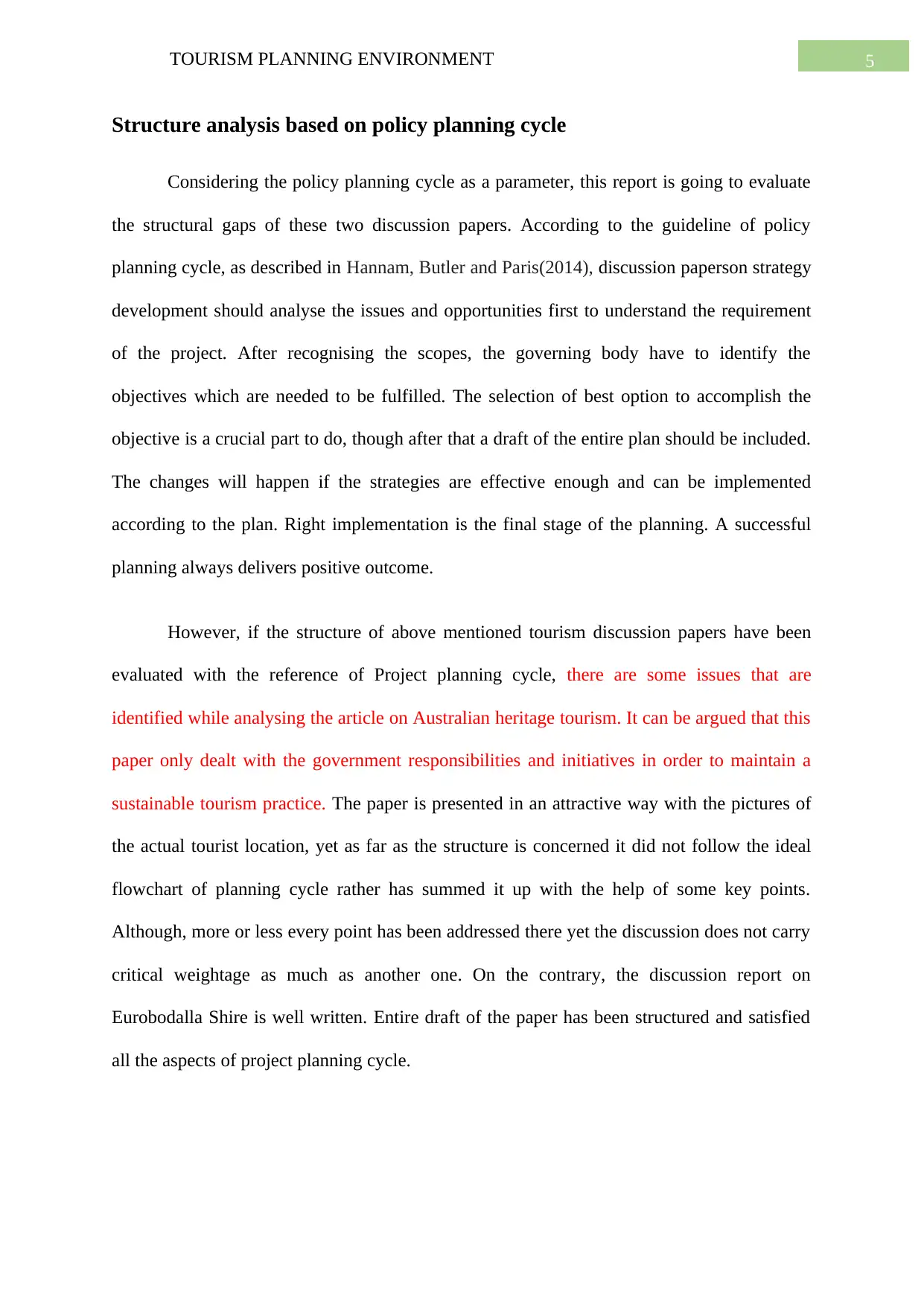
5TOURISM PLANNING ENVIRONMENT
Structure analysis based on policy planning cycle
Considering the policy planning cycle as a parameter, this report is going to evaluate
the structural gaps of these two discussion papers. According to the guideline of policy
planning cycle, as described in Hannam, Butler and Paris(2014), discussion paperson strategy
development should analyse the issues and opportunities first to understand the requirement
of the project. After recognising the scopes, the governing body have to identify the
objectives which are needed to be fulfilled. The selection of best option to accomplish the
objective is a crucial part to do, though after that a draft of the entire plan should be included.
The changes will happen if the strategies are effective enough and can be implemented
according to the plan. Right implementation is the final stage of the planning. A successful
planning always delivers positive outcome.
However, if the structure of above mentioned tourism discussion papers have been
evaluated with the reference of Project planning cycle, there are some issues that are
identified while analysing the article on Australian heritage tourism. It can be argued that this
paper only dealt with the government responsibilities and initiatives in order to maintain a
sustainable tourism practice. The paper is presented in an attractive way with the pictures of
the actual tourist location, yet as far as the structure is concerned it did not follow the ideal
flowchart of planning cycle rather has summed it up with the help of some key points.
Although, more or less every point has been addressed there yet the discussion does not carry
critical weightage as much as another one. On the contrary, the discussion report on
Eurobodalla Shire is well written. Entire draft of the paper has been structured and satisfied
all the aspects of project planning cycle.
Structure analysis based on policy planning cycle
Considering the policy planning cycle as a parameter, this report is going to evaluate
the structural gaps of these two discussion papers. According to the guideline of policy
planning cycle, as described in Hannam, Butler and Paris(2014), discussion paperson strategy
development should analyse the issues and opportunities first to understand the requirement
of the project. After recognising the scopes, the governing body have to identify the
objectives which are needed to be fulfilled. The selection of best option to accomplish the
objective is a crucial part to do, though after that a draft of the entire plan should be included.
The changes will happen if the strategies are effective enough and can be implemented
according to the plan. Right implementation is the final stage of the planning. A successful
planning always delivers positive outcome.
However, if the structure of above mentioned tourism discussion papers have been
evaluated with the reference of Project planning cycle, there are some issues that are
identified while analysing the article on Australian heritage tourism. It can be argued that this
paper only dealt with the government responsibilities and initiatives in order to maintain a
sustainable tourism practice. The paper is presented in an attractive way with the pictures of
the actual tourist location, yet as far as the structure is concerned it did not follow the ideal
flowchart of planning cycle rather has summed it up with the help of some key points.
Although, more or less every point has been addressed there yet the discussion does not carry
critical weightage as much as another one. On the contrary, the discussion report on
Eurobodalla Shire is well written. Entire draft of the paper has been structured and satisfied
all the aspects of project planning cycle.
⊘ This is a preview!⊘
Do you want full access?
Subscribe today to unlock all pages.

Trusted by 1+ million students worldwide
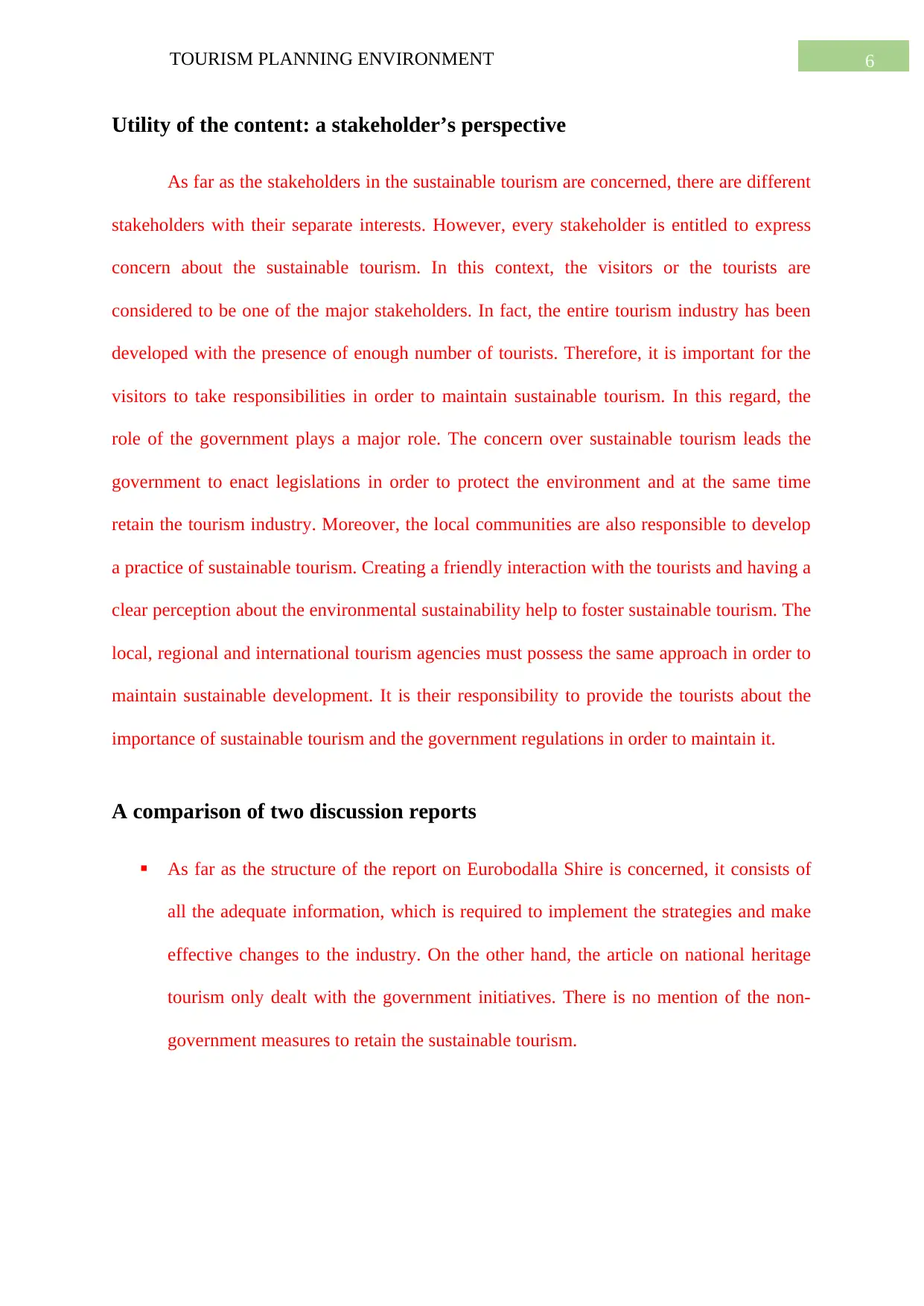
6TOURISM PLANNING ENVIRONMENT
Utility of the content: a stakeholder’s perspective
As far as the stakeholders in the sustainable tourism are concerned, there are different
stakeholders with their separate interests. However, every stakeholder is entitled to express
concern about the sustainable tourism. In this context, the visitors or the tourists are
considered to be one of the major stakeholders. In fact, the entire tourism industry has been
developed with the presence of enough number of tourists. Therefore, it is important for the
visitors to take responsibilities in order to maintain sustainable tourism. In this regard, the
role of the government plays a major role. The concern over sustainable tourism leads the
government to enact legislations in order to protect the environment and at the same time
retain the tourism industry. Moreover, the local communities are also responsible to develop
a practice of sustainable tourism. Creating a friendly interaction with the tourists and having a
clear perception about the environmental sustainability help to foster sustainable tourism. The
local, regional and international tourism agencies must possess the same approach in order to
maintain sustainable development. It is their responsibility to provide the tourists about the
importance of sustainable tourism and the government regulations in order to maintain it.
A comparison of two discussion reports
As far as the structure of the report on Eurobodalla Shire is concerned, it consists of
all the adequate information, which is required to implement the strategies and make
effective changes to the industry. On the other hand, the article on national heritage
tourism only dealt with the government initiatives. There is no mention of the non-
government measures to retain the sustainable tourism.
Utility of the content: a stakeholder’s perspective
As far as the stakeholders in the sustainable tourism are concerned, there are different
stakeholders with their separate interests. However, every stakeholder is entitled to express
concern about the sustainable tourism. In this context, the visitors or the tourists are
considered to be one of the major stakeholders. In fact, the entire tourism industry has been
developed with the presence of enough number of tourists. Therefore, it is important for the
visitors to take responsibilities in order to maintain sustainable tourism. In this regard, the
role of the government plays a major role. The concern over sustainable tourism leads the
government to enact legislations in order to protect the environment and at the same time
retain the tourism industry. Moreover, the local communities are also responsible to develop
a practice of sustainable tourism. Creating a friendly interaction with the tourists and having a
clear perception about the environmental sustainability help to foster sustainable tourism. The
local, regional and international tourism agencies must possess the same approach in order to
maintain sustainable development. It is their responsibility to provide the tourists about the
importance of sustainable tourism and the government regulations in order to maintain it.
A comparison of two discussion reports
As far as the structure of the report on Eurobodalla Shire is concerned, it consists of
all the adequate information, which is required to implement the strategies and make
effective changes to the industry. On the other hand, the article on national heritage
tourism only dealt with the government initiatives. There is no mention of the non-
government measures to retain the sustainable tourism.
Paraphrase This Document
Need a fresh take? Get an instant paraphrase of this document with our AI Paraphraser
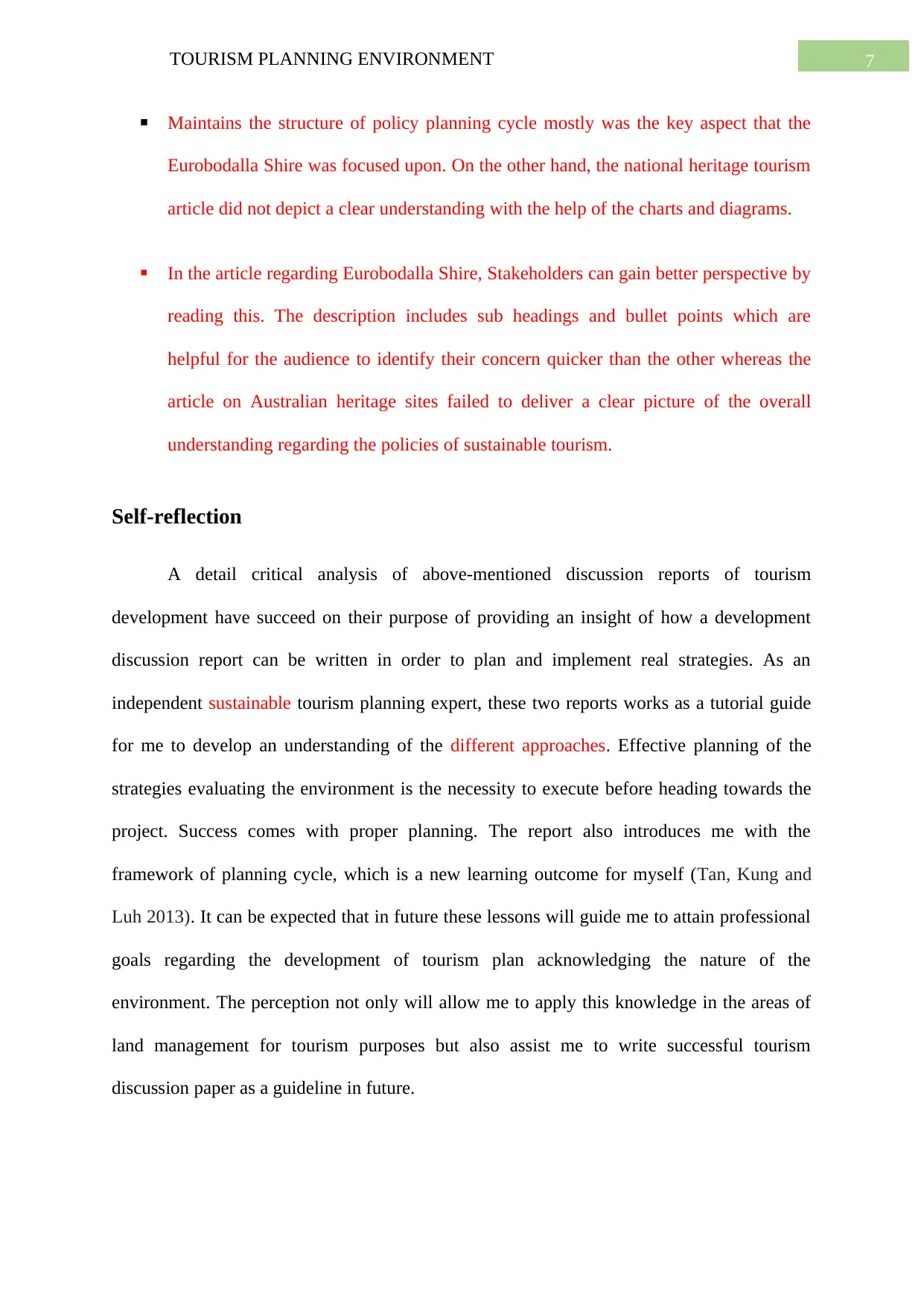
7TOURISM PLANNING ENVIRONMENT
Maintains the structure of policy planning cycle mostly was the key aspect that the
Eurobodalla Shire was focused upon. On the other hand, the national heritage tourism
article did not depict a clear understanding with the help of the charts and diagrams.
In the article regarding Eurobodalla Shire, Stakeholders can gain better perspective by
reading this. The description includes sub headings and bullet points which are
helpful for the audience to identify their concern quicker than the other whereas the
article on Australian heritage sites failed to deliver a clear picture of the overall
understanding regarding the policies of sustainable tourism.
Self-reflection
A detail critical analysis of above-mentioned discussion reports of tourism
development have succeed on their purpose of providing an insight of how a development
discussion report can be written in order to plan and implement real strategies. As an
independent sustainable tourism planning expert, these two reports works as a tutorial guide
for me to develop an understanding of the different approaches. Effective planning of the
strategies evaluating the environment is the necessity to execute before heading towards the
project. Success comes with proper planning. The report also introduces me with the
framework of planning cycle, which is a new learning outcome for myself (Tan, Kung and
Luh 2013). It can be expected that in future these lessons will guide me to attain professional
goals regarding the development of tourism plan acknowledging the nature of the
environment. The perception not only will allow me to apply this knowledge in the areas of
land management for tourism purposes but also assist me to write successful tourism
discussion paper as a guideline in future.
Maintains the structure of policy planning cycle mostly was the key aspect that the
Eurobodalla Shire was focused upon. On the other hand, the national heritage tourism
article did not depict a clear understanding with the help of the charts and diagrams.
In the article regarding Eurobodalla Shire, Stakeholders can gain better perspective by
reading this. The description includes sub headings and bullet points which are
helpful for the audience to identify their concern quicker than the other whereas the
article on Australian heritage sites failed to deliver a clear picture of the overall
understanding regarding the policies of sustainable tourism.
Self-reflection
A detail critical analysis of above-mentioned discussion reports of tourism
development have succeed on their purpose of providing an insight of how a development
discussion report can be written in order to plan and implement real strategies. As an
independent sustainable tourism planning expert, these two reports works as a tutorial guide
for me to develop an understanding of the different approaches. Effective planning of the
strategies evaluating the environment is the necessity to execute before heading towards the
project. Success comes with proper planning. The report also introduces me with the
framework of planning cycle, which is a new learning outcome for myself (Tan, Kung and
Luh 2013). It can be expected that in future these lessons will guide me to attain professional
goals regarding the development of tourism plan acknowledging the nature of the
environment. The perception not only will allow me to apply this knowledge in the areas of
land management for tourism purposes but also assist me to write successful tourism
discussion paper as a guideline in future.
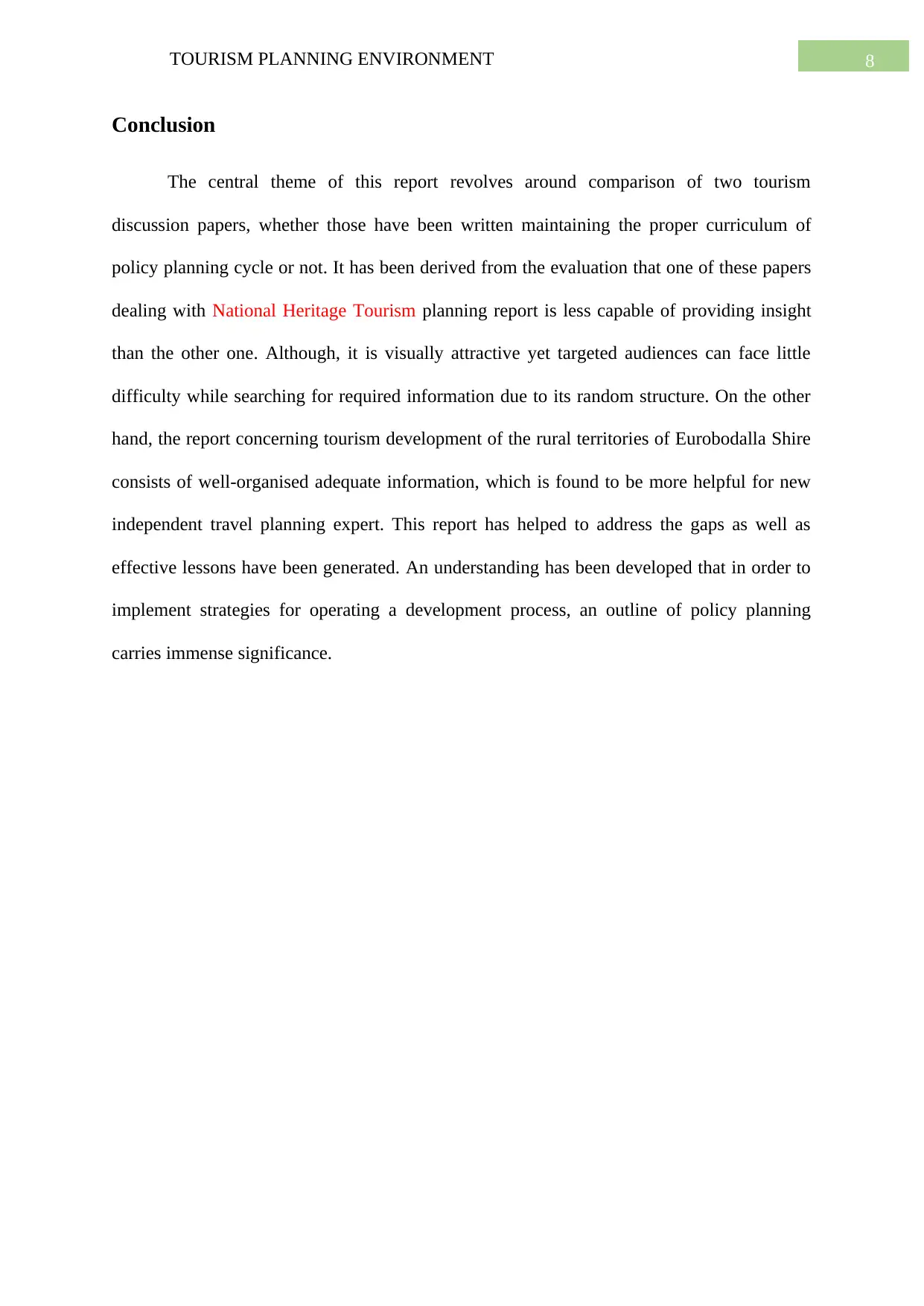
8TOURISM PLANNING ENVIRONMENT
Conclusion
The central theme of this report revolves around comparison of two tourism
discussion papers, whether those have been written maintaining the proper curriculum of
policy planning cycle or not. It has been derived from the evaluation that one of these papers
dealing with National Heritage Tourism planning report is less capable of providing insight
than the other one. Although, it is visually attractive yet targeted audiences can face little
difficulty while searching for required information due to its random structure. On the other
hand, the report concerning tourism development of the rural territories of Eurobodalla Shire
consists of well-organised adequate information, which is found to be more helpful for new
independent travel planning expert. This report has helped to address the gaps as well as
effective lessons have been generated. An understanding has been developed that in order to
implement strategies for operating a development process, an outline of policy planning
carries immense significance.
Conclusion
The central theme of this report revolves around comparison of two tourism
discussion papers, whether those have been written maintaining the proper curriculum of
policy planning cycle or not. It has been derived from the evaluation that one of these papers
dealing with National Heritage Tourism planning report is less capable of providing insight
than the other one. Although, it is visually attractive yet targeted audiences can face little
difficulty while searching for required information due to its random structure. On the other
hand, the report concerning tourism development of the rural territories of Eurobodalla Shire
consists of well-organised adequate information, which is found to be more helpful for new
independent travel planning expert. This report has helped to address the gaps as well as
effective lessons have been generated. An understanding has been developed that in order to
implement strategies for operating a development process, an outline of policy planning
carries immense significance.
⊘ This is a preview!⊘
Do you want full access?
Subscribe today to unlock all pages.

Trusted by 1+ million students worldwide
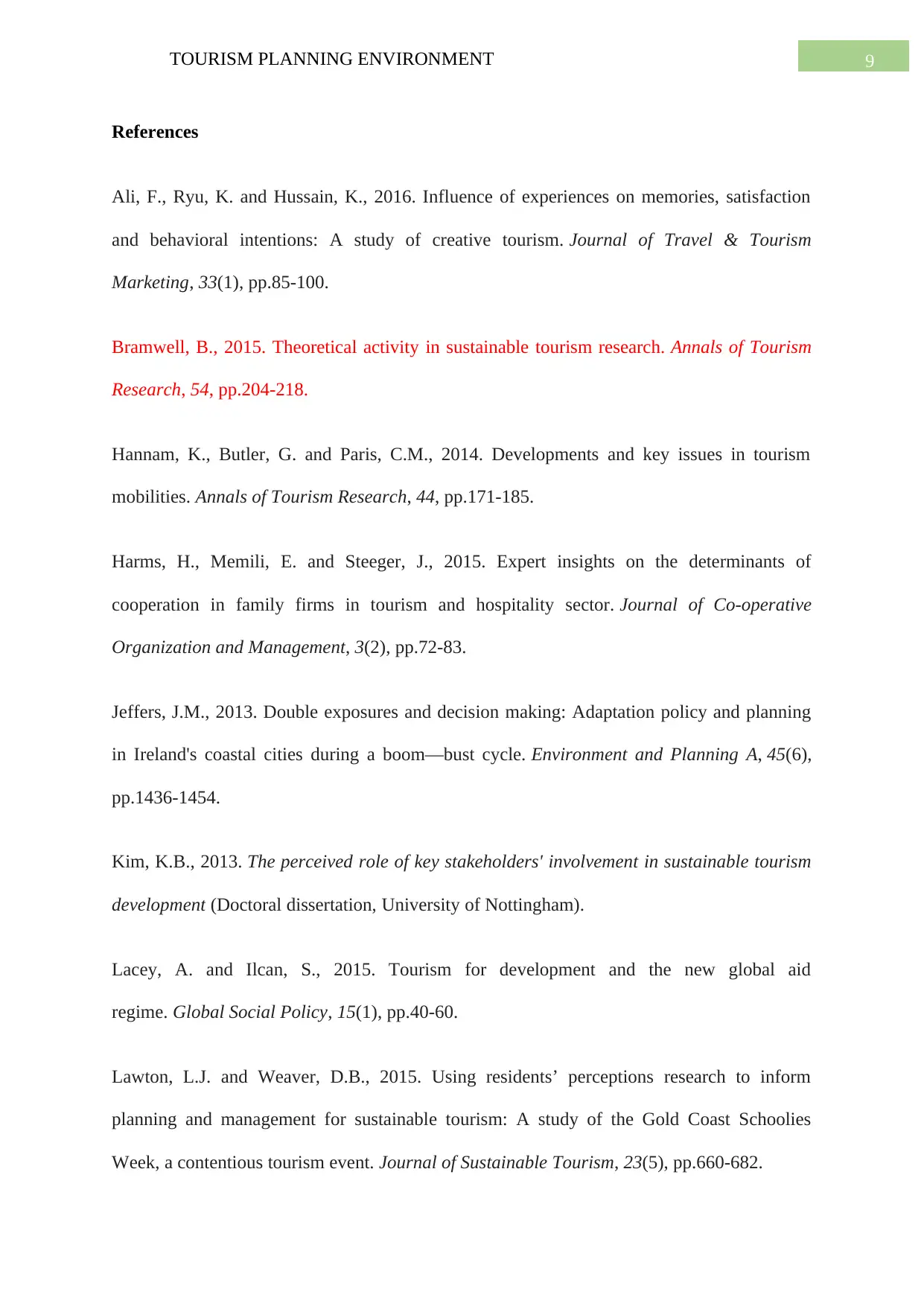
9TOURISM PLANNING ENVIRONMENT
References
Ali, F., Ryu, K. and Hussain, K., 2016. Influence of experiences on memories, satisfaction
and behavioral intentions: A study of creative tourism. Journal of Travel & Tourism
Marketing, 33(1), pp.85-100.
Bramwell, B., 2015. Theoretical activity in sustainable tourism research. Annals of Tourism
Research, 54, pp.204-218.
Hannam, K., Butler, G. and Paris, C.M., 2014. Developments and key issues in tourism
mobilities. Annals of Tourism Research, 44, pp.171-185.
Harms, H., Memili, E. and Steeger, J., 2015. Expert insights on the determinants of
cooperation in family firms in tourism and hospitality sector. Journal of Co-operative
Organization and Management, 3(2), pp.72-83.
Jeffers, J.M., 2013. Double exposures and decision making: Adaptation policy and planning
in Ireland's coastal cities during a boom—bust cycle. Environment and Planning A, 45(6),
pp.1436-1454.
Kim, K.B., 2013. The perceived role of key stakeholders' involvement in sustainable tourism
development (Doctoral dissertation, University of Nottingham).
Lacey, A. and Ilcan, S., 2015. Tourism for development and the new global aid
regime. Global Social Policy, 15(1), pp.40-60.
Lawton, L.J. and Weaver, D.B., 2015. Using residents’ perceptions research to inform
planning and management for sustainable tourism: A study of the Gold Coast Schoolies
Week, a contentious tourism event. Journal of Sustainable Tourism, 23(5), pp.660-682.
References
Ali, F., Ryu, K. and Hussain, K., 2016. Influence of experiences on memories, satisfaction
and behavioral intentions: A study of creative tourism. Journal of Travel & Tourism
Marketing, 33(1), pp.85-100.
Bramwell, B., 2015. Theoretical activity in sustainable tourism research. Annals of Tourism
Research, 54, pp.204-218.
Hannam, K., Butler, G. and Paris, C.M., 2014. Developments and key issues in tourism
mobilities. Annals of Tourism Research, 44, pp.171-185.
Harms, H., Memili, E. and Steeger, J., 2015. Expert insights on the determinants of
cooperation in family firms in tourism and hospitality sector. Journal of Co-operative
Organization and Management, 3(2), pp.72-83.
Jeffers, J.M., 2013. Double exposures and decision making: Adaptation policy and planning
in Ireland's coastal cities during a boom—bust cycle. Environment and Planning A, 45(6),
pp.1436-1454.
Kim, K.B., 2013. The perceived role of key stakeholders' involvement in sustainable tourism
development (Doctoral dissertation, University of Nottingham).
Lacey, A. and Ilcan, S., 2015. Tourism for development and the new global aid
regime. Global Social Policy, 15(1), pp.40-60.
Lawton, L.J. and Weaver, D.B., 2015. Using residents’ perceptions research to inform
planning and management for sustainable tourism: A study of the Gold Coast Schoolies
Week, a contentious tourism event. Journal of Sustainable Tourism, 23(5), pp.660-682.
Paraphrase This Document
Need a fresh take? Get an instant paraphrase of this document with our AI Paraphraser
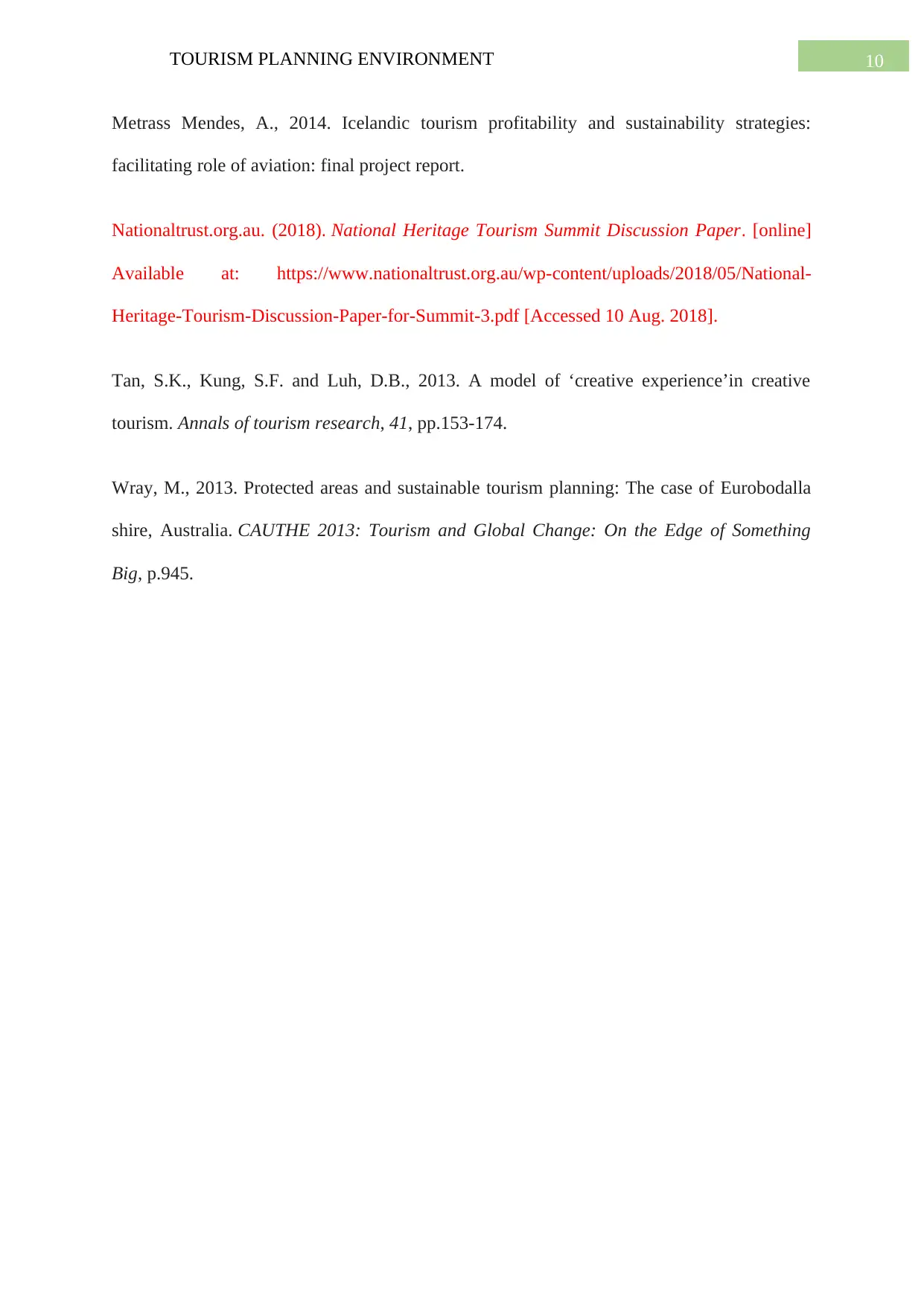
10TOURISM PLANNING ENVIRONMENT
Metrass Mendes, A., 2014. Icelandic tourism profitability and sustainability strategies:
facilitating role of aviation: final project report.
Nationaltrust.org.au. (2018). National Heritage Tourism Summit Discussion Paper. [online]
Available at: https://www.nationaltrust.org.au/wp-content/uploads/2018/05/National-
Heritage-Tourism-Discussion-Paper-for-Summit-3.pdf [Accessed 10 Aug. 2018].
Tan, S.K., Kung, S.F. and Luh, D.B., 2013. A model of ‘creative experience’in creative
tourism. Annals of tourism research, 41, pp.153-174.
Wray, M., 2013. Protected areas and sustainable tourism planning: The case of Eurobodalla
shire, Australia. CAUTHE 2013: Tourism and Global Change: On the Edge of Something
Big, p.945.
Metrass Mendes, A., 2014. Icelandic tourism profitability and sustainability strategies:
facilitating role of aviation: final project report.
Nationaltrust.org.au. (2018). National Heritage Tourism Summit Discussion Paper. [online]
Available at: https://www.nationaltrust.org.au/wp-content/uploads/2018/05/National-
Heritage-Tourism-Discussion-Paper-for-Summit-3.pdf [Accessed 10 Aug. 2018].
Tan, S.K., Kung, S.F. and Luh, D.B., 2013. A model of ‘creative experience’in creative
tourism. Annals of tourism research, 41, pp.153-174.
Wray, M., 2013. Protected areas and sustainable tourism planning: The case of Eurobodalla
shire, Australia. CAUTHE 2013: Tourism and Global Change: On the Edge of Something
Big, p.945.
1 out of 11
Related Documents
Your All-in-One AI-Powered Toolkit for Academic Success.
+13062052269
info@desklib.com
Available 24*7 on WhatsApp / Email
![[object Object]](/_next/static/media/star-bottom.7253800d.svg)
Unlock your academic potential
Copyright © 2020–2025 A2Z Services. All Rights Reserved. Developed and managed by ZUCOL.




